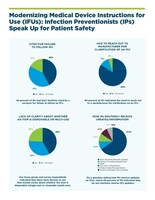Cleaning Instructions for Medical Instruments Need an Overhaul
News provided by
Association for Professionals in Infection Control and EpidemiologyMay 16, 2024, 12:23 ET
Infection Preventionists call for improvements in inefficient and risky instructions for medical devices
ARLINGTON, Va., May 16, 2024 /PRNewswire/ -- Infection preventionists are reaching out to policymakers for help with the regulatory process around the current convoluted medical device cleaning instructions, known as instructions for use or IFUs, with which they must comply and are calling for reform to put patient safety and healthcare efficiency in the forefront.
In a groundbreaking report published today by the Association for Professionals in Infection Control and Epidemiology (APIC), the group identified the myriad of difficulties, inefficiencies, and wasted time and money spent on deciphering cleaning instructions for medical instruments. The report states that IFUs, "are often not available, difficult to locate, out-of-date, overly complex, brand specific, and/or provide instructions that seem focused on protecting medical devices and their warranties rather than protecting patients from being exposed to pathogens."
The report, "Modernizing Medical Device Instructions for Use (IFUs): Infection Preventionists Speak Up for Patient Safety," was shared with policymakers and the U.S. Food and Drug Administration (FDA), which regulates medical device labelling.
Infection preventionists (IPs) are charged with monitoring cleaning adherence to IFUs in healthcare facilities and say that this burdensome process takes an inordinate amount of time away from other core patient safety responsibilities. In addition to diverting attention from patient safety, the current system wastes countless hours of labor and financial resources in the U.S. healthcare system.
The new APIC report outlines a long list of concerns about IFUs.
In a 2023 APIC survey of 1,198 IPs, respondents found IFUs unnecessarily complex, difficult, or time consuming (70.6%); said instructions seemed designed to address product lifespan more than prevention of healthcare-associated infections (HAIs) (70.2%); and said the IFUs lacked specificity/clarity about how to appropriately clean the product (68.3%).
The numerous IFUs are so confounding and time-consuming to comply with that 84% of IPs surveyed were forced to reach out to manufacturers for clarity; 36% reported that manufacturers did not have helpful information. Finally, 8% took the additional step of contacting the FDA to make sure they were properly complying with cleaning, disinfection, and/or sterilization (CDS) protocols.
"The time that IPs must spend obtaining clarity on arcane and confusing cleaning instructions limits the amount of time they are able to spend on other lifesaving infection prevention work," said 2024 APIC President Tania Bubb, PhD, RN, CIC, FAPIC. "This is especially true for individual IPs working alone in their facilities, as about half of our survey respondents were."
Despite trying diligently to comply with complex IFUs, 42% of IPs said that they were cited by surveying bodies for IFU violations, and that 54% of them were unable to successfully challenge the citation even by bringing forward scientific evidence. Surveying bodies operate as agents for the Centers for Medicare & Medicaid Services, surveying hospitals on the agency's behalf.
Sixty-five percent of IPs reported that they have the biggest CDS difficulties with non-critical devices, such as blood pressure cuffs.
To address these issues APIC recommends:
- Developing tools to help IPs and other healthcare personnel navigate the current laborious and inefficient process for cleaning, disinfection, and sterilization of medical instruments.
- Bringing problematic IFUs to the attention of manufacturers and the FDA.
- Educating policymakers and healthcare organizations about flaws in the current regulatory framework that limit IPs' ability to protect patients from the transmission of HAIs from medical devices.
- Convening stakeholder organizations to work with APIC to propose a new regulatory framework for cleaning, disinfection, and sterilization of medical devices that includes (but is not limited to):
- A standardized format for IFUs.
- IFU language that takes into account the needs of infection prevention and control, sterile processing, environmental services, and end users to protect patients.
- Device labels that are easily accessible to users for the duration of the product's lifespan, indicate when the IFU was last updated, and provide information on whom users may contact in case of questions.
- A public repository for IFUs so that users will have access to appropriate information for devices that are no longer manufactured and/or when the manufacturer is no longer in business.
"APIC urges policymakers, industry, and allied groups to come together on solutions to make confusing device cleaning instructions clear, concise, and rooted in the principles of infection prevention and control to protect patients from deadly pathogens," said Dr. Bubb. "Instructions that are so unclear that more than 8 in 10 IPs need to call the company for clarity are inefficient and need revision. We stand ready to help improve and standardize this process."
Founded in 1972, the Association for Professionals in Infection Control and Epidemiology (APIC) is the leading association for infection preventionists and epidemiologists. With more than 15,000 members, APIC advances the science and practice of infection prevention and control. APIC carries out its mission through research, advocacy, and patient safety; education, credentialing, and certification; and fostering development of the infection prevention and control workforce of the future. Together with our members and partners, we are working toward a safer world through the prevention of infection. Join us and learn more at apic.org.
SOURCE Association for Professionals in Infection Control and Epidemiology

WANT YOUR COMPANY'S NEWS FEATURED ON PRNEWSWIRE.COM?
Newsrooms &
Influencers
Digital Media
Outlets
Journalists
Opted In

Share this article